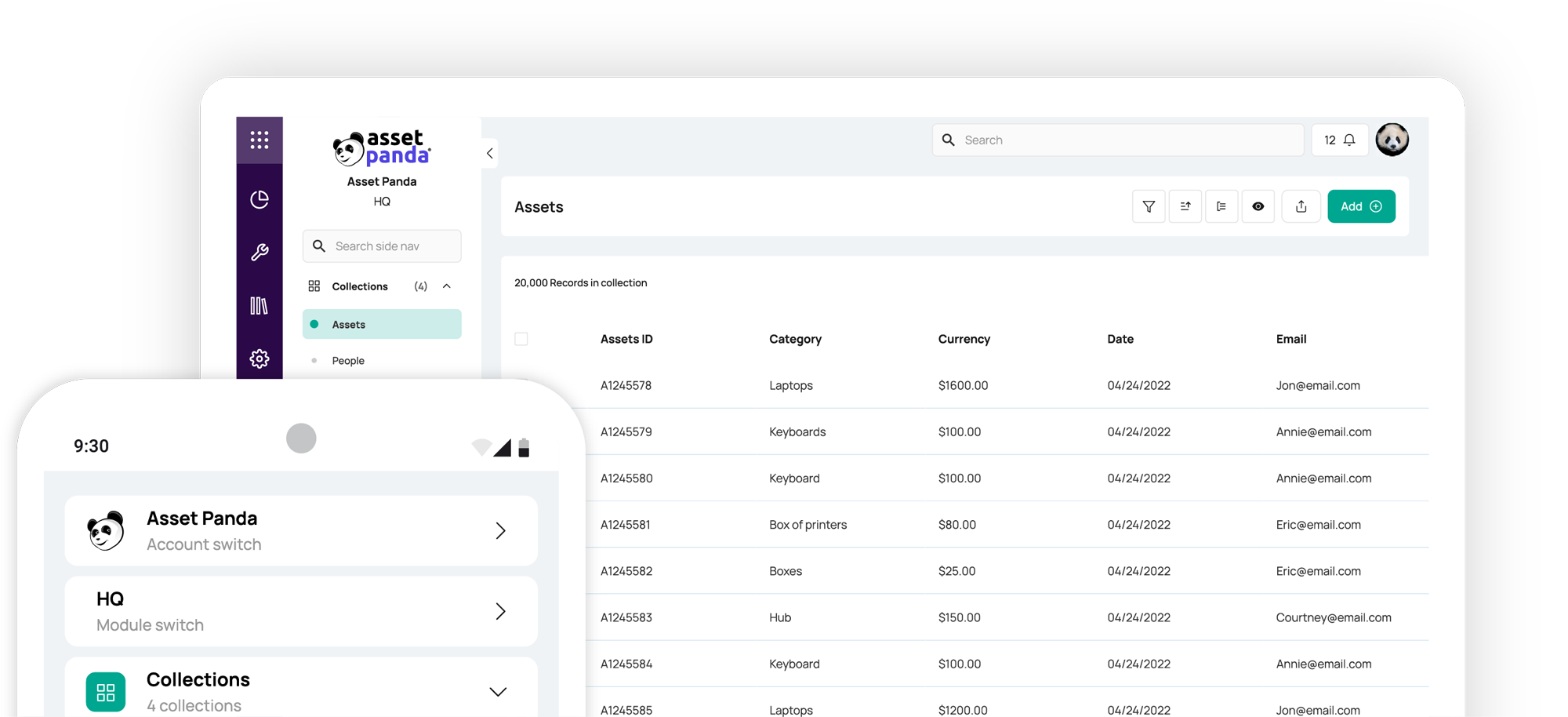How Much Does Asset Tracking Cost? 7 Key Factors to Consider
Blog

Table of Contents
Take Control of Your Assets
A personalized demo is just one click away.
Asset tracking software is an essential investment for businesses that want to keep tabs on their equipment, inventory, and other valuable assets. But how much does asset tracking cost? The answer isn’t one-size-fits-all. The asset tracking cost for any given company can vary widely depending on factors like business size, chosen technology, and specific needs. In this comprehensive guide, we’ll break down the costs of asset tracking for U.S.-based companies across all sectors, explore why seemingly free methods like spreadsheets often end up costing more, and compare options (cloud vs. on-premise) to help you get the most value for your budget.
Why Spreadsheets Won’t Save You Money
It’s common for small businesses to start tracking assets with spreadsheets, thinking it’s a “free” solution. However, relying on spreadsheets or other low-to-no-cost methods won’t actually save you money – in fact, it can cost you more in the long run.
Manual tracking is time-consuming and error-prone. Employees often have to enter data multiple times (on paper, then into a spreadsheet) and double-check information, all of which is paid time that adds up. Human data entry mistakes are almost inevitable, and they can lead to costly consequences. In fact, 98% of office workers reported seeing spreadsheet errors that cost their companies money. These errors might result in over-ordering assets, misplacing equipment, or failing to service an asset on schedule – each mistake carrying a price tag. Moreover, spreadsheets provide only a static, outdated snapshot. They lack real-time updates, so your team might be making decisions based on old information, potentially causing downtime or duplicate purchases.
While a spreadsheet itself has no licensing fee, the asset tracking cost of using spreadsheets comes in other forms: wasted labor hours, operational inefficiencies, and risk of asset loss or compliance penalties. Modern asset tracking software can mitigate these issues by providing accurate, real-time data and automation that spreadsheets simply can’t match.
7 Key Factors That Affect Asset Tracking Cost
If you’re evaluating asset tracking costs for your business, it’s important to understand the various factors that influence pricing. Asset tracking solutions come in a range of packages and pricing models. Here are some key factors that affect how much you’ll pay for an asset management system:
1. Number of Assets
The more assets you need to track, the higher the cost is likely to be. Many software providers tier their pricing based on asset count (for example, up to 500 assets, up to 5,000 assets, etc.). As your asset inventory grows, you may need to upgrade to a higher plan.
2. Number of Users
Some platforms charge per user or have limits on the number of users/admins within certain plans. Others offer unlimited users on all plans. If a platform’s pricing is user-based, more team members using the system will increase your costs.
3. Asset Tags and Hardware
Consider the cost of tagging and tracking hardware. Basic printed barcode or QR code labels are inexpensive, but more advanced tags like RFID chips or GPS trackers cost more. Most software vendors expect you to purchase tags or devices separately, which adds to the overall asset tracking cost. For instance, rugged GPS asset trackers for vehicles can range from roughly $100 to $500 each, depending on features and durability.
4. Advanced Tracking Technology
If you require support for technologies like active RFID, Bluetooth beacons, or real-time GPS tracking, those capabilities might only be available in higher-tier plans or as add-ons. Advanced sensors and IoT integrations can increase costs but may be crucial for certain industries (like logistics or construction) that need live location data.
5. Integrations and Features
The breadth of features and integrations with other software will influence price. Basic plans might include asset check-in/check-out and simple reporting, whereas more expensive plans offer advanced reporting, maintenance scheduling, API access, and integration with systems like ERP or IT service management tools. Each integration or premium feature (such as predictive maintenance analytics) might carry an extra fee on some platforms.
6. Customer Support and Training
Low-cost or budget solutions may include only limited support (e.g., email support during business hours) or offer add-on support hours. Higher-end solutions often come with 24/7 support or a dedicated account manager and even one-on-one onboarding training. Consider the level of support your team will want and whether or not it's baked into the overall platform fee.
7. Deployment Method
Pricing can differ based on whether the software is cloud-based (hosted by the vendor) or on-premise (hosted on your company’s servers). Cloud solutions usually have lower upfront costs but recurring subscription fees. On-premise solutions might offer a one-time license that could be cheaper long-term for large deployments, but you’ll need to invest in and maintain your own server infrastructure and IT staff.
Understanding these factors will help you estimate how much asset tracking will cost for your situation. Next, we’ll look at typical price ranges for asset tracking software based on business size.
Average Cost of Asset Tracking Software by Business Size
How much does asset tracking cost for a small business vs an enterprise corporation? While the number varies between solutions, generally the cost scales up with the complexity and volume of assets. Below, we break down average software costs for small, mid-sized, and enterprise businesses in the U.S.
To start, many vendors offer tiered plans that align with business size or needs. A recent software pricing guide indicates that small business plans (often called personal or basic plans) average around $15–$30 per user per month, whereas mid-tier business plans might range $50–$100 per user per month, and enterprise plans can run $150+ per user per month for full features and support.
Some vendors even provide a free tier, which includes limited features and assets for very small operations. On the other hand, enterprise-grade solutions with advanced capabilities can cost well above these ranges, especially if priced per asset or requiring custom implementation.
For a clearer snapshot, consider the table below summarizing typical asset tracking software costs by business size:
Business Size | Typical Pricing (Cloud Subscription) | Key Features in This Tier |
| Small Business | Free to ~$100/month for basic plans; or about $15–$30 per user/month on paid plans. Some entry-level plans start as low as ~$10/month. | Basic asset tracking, mobile app or barcode scanning, standard reports. May have limits on number of assets or users. Basic email support. |
| Mid-Sized Business | Roughly $100–$500 per month (depending on number of users/assets), equating to about $50–$100 per user/month for more feature-rich “Business” plans. | Advanced tracking features (e.g. maintenance scheduling, integrations with other software), higher asset or user count, priority support. Often includes API access and better customization. |
| Enterprise | Often $500+ per month or custom pricing. This may translate to $150–$300+ per user/month for enterprise-grade platforms. Annual costs can range from around $10,000 to well into six figures for very large deployments. | Unlimited or very high asset counts, full suite of features (custom integrations, advanced analytics, dedicated account manager). Premium 24/7 support and onboarding services included. |
Keep in mind that some providers price by number of assets tracked rather than per user. For example, one cloud-based asset tracking platform (with unlimited users) starts around $1,500 per year for a small package tracking up to ~500 assets. That comes out to roughly $125 per month for a small business in that scenario.
As you scale up, costs grow: another more premium solution might start at about $1,300 per year for a base package, but that package could allow unlimited assets and include more advanced features. The range is wide – asset tracking costs can span from as little as ~$10–$50 per month for a simple small-business system to thousands per month for enterprise implementations. In general, most entry-level asset tracking products in 2025 start in the ballpark of $10 to $100 per month as a base subscription, whereas high-end or enterprise systems require getting a custom quote.
The Unexpected Costs of an Improper Asset Tracking Solution
We’ve discussed the direct costs of asset tracking software, but what about the costs of not having a good system in place? Companies that stick with ad-hoc methods or outdated systems often encounter many unexpected expenses. These hidden costs can easily outweigh the price of a modern asset tracking solution. Here are some of the major costs you may face without proper asset management:
Lost or Misplaced Assets (and the Labor to Find Them)
Without real-time asset tracking, equipment and tools can get lost or misplaced frequently. Employees then spend hours searching for what they need. Multiply such incidents across a year, and the financial impact is significant.
Duplicate Purchases
Poor tracking often leads to buying items you already have. If your spreadsheet or manual log isn’t up-to-date, you might think you’re out of an item and re-order it, only to later find the original. Many businesses have ended up with duplicate tools or equipment due to lack of visibility.
Ghost Assets and Write-Offs
Another side effect of manual tracking is inaccurate records showing ghost assets that don’t actually exist or are no longer usable. These ghost assets might be lost, stolen, or disposed of without proper documentation, which can skew your financial statements and insurance coverage. Eventually, companies have to write off these assets, taking a financial hit. There’s also the risk of continuing to pay insurance or taxes on assets you don’t actually have due to record-keeping errors.
Data Errors and Audit Costs
As mentioned, human error in spreadsheets can cause big mistakes. Imagine mis-typing an asset ID or a quantity and failing to account for a piece of equipment. Correcting these errors retroactively (through audits, recounts, investigations) is a costly process in terms of labor hours. Some errors might even result in financial penalties if they cause misreporting of assets on balance sheets or tax filings.
Downtime and Operational Delays
If a critical asset isn’t where it’s supposed to be and you have no fast way to locate it, projects can get delayed. For example, if a piece of machinery is missing when needed, a construction job might halt for a day, or a delivery might be missed. The cost of downtime — workers idled or production stopped — can dwarf the cost of the asset itself. A proper asset tracking system helps you quickly locate spares or reassign assets to avoid downtime.
Non-Compliance Fines and Safety Risks
In some industries, not having the right equipment on hand isn’t just inconvenient, it’s illegal or dangerous. For instance, OSHA regulations mandate certain safety equipment be present on job sites. If an item went missing and wasn’t replaced because your tracking failed, you could face fines for non-compliance. Similarly, missing maintenance on an asset (because the schedule was tracked informally and got overlooked) could lead to accidents or regulatory violations. The costs here include fines, legal liabilities, and reputational damage.
As these points illustrate, the cost of poor asset management can be staggering – often many times more than the cost of a good software solution. Investing in a proper system is not just about convenience; it’s about avoiding waste, preventing loss, and even protecting your business from financial and legal risks.
The Asset Panda Advantage
At the end of the day, determining how much asset tracking costs comes down to balancing price with value. A cheap solution that doesn’t address your needs can end up costing more through inefficiencies, while a robust solution can save significant money despite its price tag. This is where Asset Panda shines as a smart investment for asset tracking.
Asset Panda’s powerful cloud-based platform helps businesses of all sizes maintain control of their assets. With clear visibility into the real-time status of your assets along with their full lifecycle history, your team can proactively maintain assets and optimize utilization, saving you money in the long run.
Our highly customizable platform provides an intuitive experience for all your users so you can drive fast time to value and high ROI. With user-based pricing, your organization pays for exactly what you need–nothing more, nothing less.
Ready to see Asset Panda’s cost-effective solution in action? Schedule your personalized demo today.
Take Control of Your Assets
A personalized demo is just one click away.
Related News & Press
Learn more from a solution specialist
Schedule a demo to find out how you can transform your workflows with Asset Panda Pro
Contact our team at (888) 928-6112



